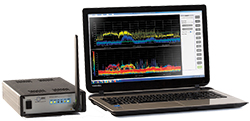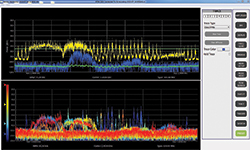
Berkeley Nucleonics (BNC) has developed and introduced a next generation, high performance, real-time spectrum analyzer (RTSA) at one-tenth the cost and one-tenth the size and weight of a typical benchtop RTSA. At the same time, it has 10× the performance of a portable handheld spectrum analyzer at half the cost. This leapfrog in technology by BNC is poised to revolutionize the $700 million per year spectrum analyzer test and measurement market. RTSAs allow engineers to see the spectrum as they never have before — in real-time — which means never missing any signals, wanted or unwanted.
An RTSA processes RF fast enough to not miss any signals within its given capture bandwidth, known as its real-time bandwidth (RTBW). It provides views of the spectrum in the frequency and time domains, as well as power spectral density, to enable analysis of signals that may be so fast as to be undetectable to the human eye. An RTSA must also have the capability to trigger on and capture events, recording them for playback and deeper analysis.
The BNC RTSA7500 is a family of PC-controlled RTSAs offered in three upper frequency ranges, from 100 kHz to 8, 18 or 27 GHz. These analyzers are unique in their ability to be operated either remotely over an IP network or by direct connection to a PC. The RTSA7500 features RTBW up to 100 MHz, probability of intercept (POI) as short as 1 µs and a spurious free dynamic range (SFDR) up to 100 dBc. The RTSA7500 consists of software that runs on a PC with Windows 7, 8 or 10 and hardware comprised of a high performance software-defined radio receiver and wideband digitizer.
The RTSA7500 can be utilized anywhere in the wireless ecosystem: R&D, education, manufacturing, deployment and monitoring. Anyone dealing with signals that vary dynamically in amplitude or are agile in frequency can increase their productivity with a real-time spectrum analyzer. Examples include fast intermittent signals, pulsed signals, frequency-hopping signals, signals hidden underneath signals and multi-signal environments sharing the same spectrum in license-free bands (see Figure 1). In addition, the RTSA7500 is versatile enough to be able to analyze conventional CW signals and analog modulation formats.

Figure 1 BNC RTSA7500 display showing Wi-Fi and Bluetooth signals at 2.4 GHz.
The BNC RTSA7500 solution consists of the following real-time capabilities: spectrum graph, spectrogram view, power spectral density display (persistence), triggering, I/Q plots, and recording and playback. Users can choose between standard swept-tuned spectrum analysis and real-time spectrum analysis with choices of 10, 40 or 100 MHz real-time bandwidth. Users can also select the high dynamic range mode featuring 100 dBc dynamic range for making critical IP3 measurements.
The RTSA7500 is extensible, which allows OEMs to add additional functionality with a 10 MHz input/output reference for multi-unit synchronization. This allows multiple RTSA7500s to be linked to one another in complete phase-coherence with one another and allowing multiple spectrum to be viewed, in real-time, simultaneously. Analog I/Q outputs can be used with OEM high speed digitizers for 80 or 160 MHz RTBW. The product includes the PC-based Real-Time Spectrum Analysis software, a GPIO port for external triggers and exterior modules such as antenna switches and down-converters and optional support for external local oscillator inputs, to enable phase-coherent radio front-ends.
BNC utilizes industry-leading APIs and open-source code for easy customization and remote control. Programming languages supported are Python™, LabVIEW, MATLAB® and C/C++. Standard protocols and file formats include SCPI, VRT and CSV. For networking and remote applications, the RTSA7500 uses Gigabit Ethernet, making it convenient for the manufacturing environment and remote spectrum management applications. With record and playback files, deeper analysis can be conducted on any PC or multiple PCs running the RTSA software without the instrument being attached.
The cost, size and weight of conventional real-time spectrum analyzers have relegated them to the bench of the mostly R&D intensive military-aerospace industry. BNC’s solution now makes RTSAs affordable and portable for all scenarios, whether on the bench for R&D, on the manufacturing floor or in the field for wireless deployment, interference and bug hunting or spectrum monitoring.
Wireless systems are evolving rapidly, with wider bandwidths, higher order modulation and more frequencies — all of which have to coexist. The Internet of Things (IoT) is about to explode, bringing millions of new wireless devices to market that must be engineered, manufactured and deployed. BNC is at the forefront of this technology shift, capitalizing on these new wireless device test requirements with its patented, high performance, low cost, software-defined radio technology, open-source software, standard APIs and a PC-controlled, networked architecture that provides unparalleled performance for the price.
Berkeley Nucleonics
San Rafael, Calif.
(415) 453-9955
rfsales@berkeleynucleonics.com
http://rf.berkeleynucleonics.com/MWRTSA
